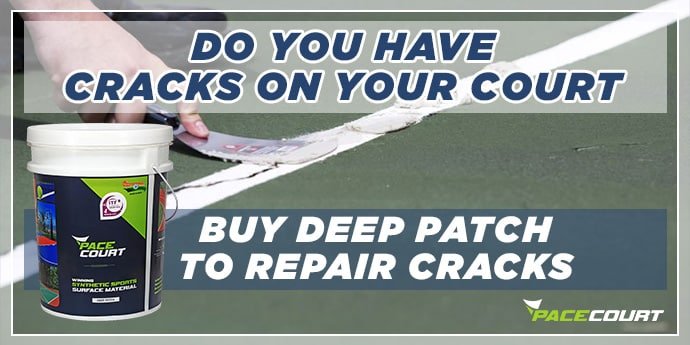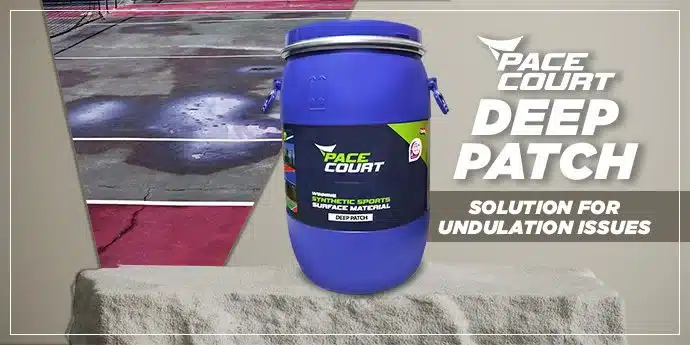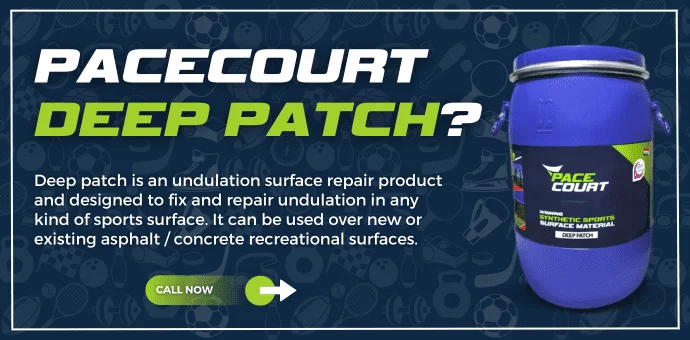Introduction
Tennis courts are more than just places to play; they serve as hubs for competition, happiness, and physical fitness for a vast number of people worldwide. However, just like any other outdoor building, tennis courts are extremely prone to deterioration. Other major hazards on outdoor tennis courts are cracks. Crackles are not only ugly, but they also compromise gameplay and safety. We at Pacecourt understand how important it is to maintain clean courts. This comprehensive guide will examine the reasons for these cracks, the importance of prompt repairs, and those instances where we've done a great job of correcting them.
Understanding the Causes of Cracks in Tennis Courts
Before diving into the repair methods, it's essential to understand why cracks occur in the first place. Several factors can contribute to the development of cracks in outdoor tennis courts:
- Weather Conditions: Variations in temperature, especially in regions experiencing freeze-thaw cycles, may cause the court surface to expand and contract. Fractures will eventually arise from this repeated tension.
- Poor Installation: Weak building techniques or inferior materials could result in a weak foundation. As it ages, a poorly constructed court would be more vulnerable to cracks.
- Aging:Like all surfaces, tennis courts gradually change over time. Eventually, the adhesive holding the surface particles in place may degrade, causing fractures to appear.
- Heavy Usage:Increased deterioration may result from intense court activities. Conversely, courts used for regular games or competitions may experience cracking sooner than courts used for infrequent usage.
- Lack of Maintenance: Even the slightest issues might worsen if routine maintenance neglected; little cracks can enlarge into large holes in the wall.
Why Timely Repair is Crucial
Cracks in your tennis court need fixing immediately, otherwise, waiting longer may worsen the condition. Here are some reasons why repairs should done immediately.
- Safety Concerns: Holes or cracks on the playing surface may present a danger of tripping, which consequently raises the chances of getting injured.
- Playing Experience: The bouncing of balls and the movement of players on rough ground can have a negative impact on the playing experience.
- Aesthetic Appeal:At the point when breaks happen on a structure, they make it terrible, consequently decreasing its appearance.
- Cost-Efficiency: Cracks can be fixed before they become larger issues, saving money on repairs in the long run.
Identifying When Repair is Needed
To know when to fix any cracks you may have, it is important to measure their size, depth, and position. Some tips are as follows:
- Hairline Cracks: Most of the time, small cracks less than 1/8 inch wide don't need to be treated as an emergency; rather, they just need to be watched. When kept up appropriately, they can stay in their unique size.
- Medium Cracks:It is essential to act quickly regarding cracks that range from 1/8 inch to 1/2 inch in width. The water may penetrate these cracks and aggravate the situation.
- Large Cracks: More than a half-inch crack repairs should done immediately because they are not things you joke about. Serious harm shown to them and can result in affecting the construction of the court itself.
- Location: If we want to safely protect our players and ball integrity, it is better to fix the cracks in the most used places like the baseline or service box.
Repair Methods for Tennis Court Cracks
We have six typical methods that we use for repairing tennis courts at Pacecourt. These include:
- Crack Sealing: To fill the crack, it is necessary to put in a flexible sealant that prevents water from entering and causing more damage. This way of doing things will work best for small cracks, and it will not use much material or time.
- Crack Filling: You know what? When we have to deal with bigger fissures, we usually make use of sophisticated materials that are able to adapt to temperature fluctuations, thus ensuring a long-lasting repair solution.
- Overlay Systems: In cases where there are numerous fissures in the courts, it might be required to install an overlay system. An overlay system consists of putting in place another coat of asphalt or acrylic on top of what is already there, thus giving rise to a new and smooth surface for playing purposes.
- Resurfacing: When dealing with courts that have multiple fractures and other damage, resurfacing may be an ideal course of action. It entails stripping off the uppermost layer of the court and replacing it by placing a new surface on top.

Case Studies: Pacecourt's Expertise in Action
Case Study 1: High School Tennis Facility
A high school in a cold region saw several big splits forming on their courts. These cracks were impeding play and also posed safety hazards. Pacecourt made an extensive evaluation and found that the cracks were a result of old asphalt and cycles of freeze-thaw. There was a suggestion for a crack filling and overlay system. The whole job took only two weeks, after which courts were set for upcoming game seasons. The school was delighted with these outcomes as they observed better playability and beauty.
Case Study 2: Private Tennis Club
Heavy use and lack of care caused serious damage to the championship court of this private tennis club. This had an impact on ball bounce as well as the game itself. Pacecourt suggested a resurfacing solution. Our team got rid of the old surface, fixed up the cracks, then added a fresh coat of acrylic material. Members of the club were awed at how much better it looked and felt to play there.
Case Study 3: Community Recreation Center
There were outdoor courts at a community recreational center that had varying degrees of cracking. A cost-effective solution that could extend the lifespan of the courts required by the center. A blend of crack sealing and spot resurfacing suggested by Pacecourt. The work finished on budget and early, letting the community use their courts without disturbance.
Maintenance Tips to Prevent Cracks
Preventive maintenance is key to prolonging the life of your tennis court. Here are some tips to keep your court in top condition:
- Regular Cleaning: The surface compromised trash, soil, and algae. For the court's appearance and functionality to preserved, regular cleaning of paramount importance.
- Scheduled Inspections:Regular checks performed by specialists can pinch early indicators of wear, leading to prompt fixing.
- Proper Drainage: This helps to avoid stagnant water on the court, which most likely causes cresting.
- Resurfacing Schedule: Resurfacing every four to eight years can keep the court in pristine shape, based on usage and climate.
- Use of Protective Gear: To minimize surface damage encourage players to wear the right shoes
If You Want To
Repair
Your Tennis Court Please

Conclusion
One must stay alert and keep up with the maintenance of an outdoor tennis court. Every court will experience cracks sooner or later; however, fixing these right away can prevent them from manifesting into bigger problems. When it comes to repairing and maintaining quality tennis courts, we at Pacecourt have got things covered for you. From small fissures to complete repainting, we undertake all kinds of renovations for tennis courts. Get in touch with us right now to know more about how we can help in maintaining your courts well.
In the end, we would like to say that tennis court repair starts with comprehending how the cracks begin to develop, and learning about the best practices for tennis court maintenance. Even after the crack occurs don’t use temporary measures to fix it; hire an expert, like Pacecourt for tennis court maintenance and repair. To learn more about our product and how to maintain the quality of the tennis court; contact us.
Frequently Asking Question
The proper maintenance is the key to ensure your court beauty. It will prevent cracks and maintain the tennis court surface. Other steps to ensure court strength is to clean the court with mild detergent, remove the standing water, remove the debris and foreign objects, hire experts for cleaning, and prevent unnecessary damage from sharp objects.
To fix tennis court cracks on asphalt or concrete surfaces, use Pacecourt Deep Patch. The product works well on the different types of sports surfaces and the result is smooth tennis court.
The cost of acrylic flooring varies based on the number of layers and specific project details. Typically, a 5-layer system costs around 50 INR per square foot, while an 8-layer system costs around 70 INR per square foot, including materials and installation.





